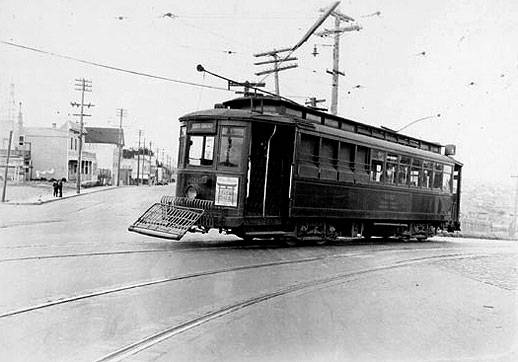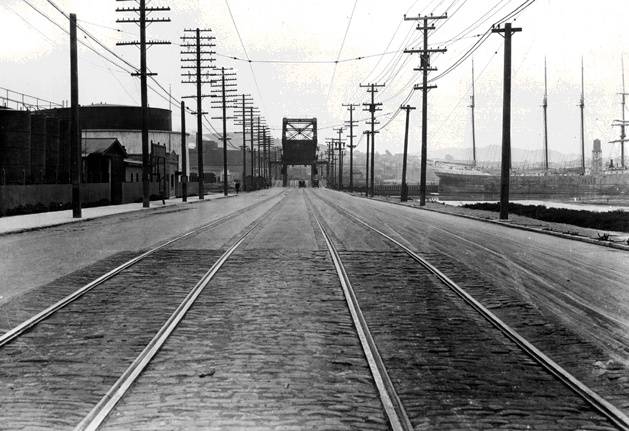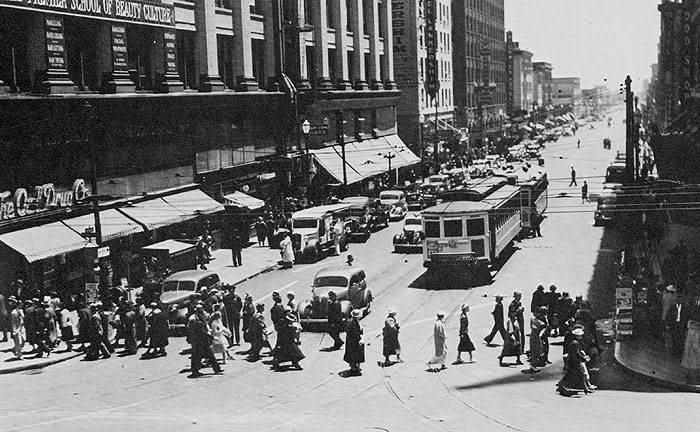1920s Transport To and From Bayview
"I was there..."
By Ruth Eshow Upton
(Originally titled "HOW WE GOT THERE FROM HERE")
Line #29 of the Market Street Railway, turning from 3rd Street onto San Bruno Avenue, 1930s.
The Market Street Railway ran three street cars to serve the Bayview. They were the #l6, #29 and #25. The #l6 started at the Ferry Building, followed Third Street to the Six Mile House on County Road and Sunnyvale in Visitacion Valley. The #29 also went on Third, starting at Broadway and Davis, terminating at the Five Mile House at San Bruno and Wilde. (it was pronounced “Wildee” by the locals.) There was another car, the #40, which I vaguely remember as going under a tunnel and ending up at the Tanforan Race Track, but no one in the neighborhood took it, as far as I knew.
The #25 started at Fifth and Market, wended its way down Bryant, swung over to Potrero, turned to San Bruno for the final stretch, ending at the Five Mile House, just a few blocks past our stop on Le Conte Avenue.
We rode the #l6 whenever we needed to take a ferry to cross the bay. The long ride had its distractions. It passed the Four Mile House (famous for Friday night cioppino dinners, pronounced chupeen), and the old Opera House before stopping at the Evans Avenue cross street. It was not unusual to halt to let cowboys drive their livestock to the slaughter houses in Hunters Point. Looking into the bloodshot eyes and hearing sad moans of cattle being herded to their death was unsettling.
Looking south on 3rd Street from Army to Islais Creek bridge, August 1, 1921.
Photo: Gaar Collection, San Francisco, CA
Suspense mounted as we approached the Islais Creek bridge. Would we make it before the drawbridge went up? To wait for the drawbridge to slowly rise, the vessel pass through and finally gently lower itself to street level guaranteed a late arrival at one’s destination. In l937 I went to work in an office in the Merchants Exchange Building in the Financial District. I took the #l6, which took me closest to Montgomery Street, every day. If I happened to arrive a little late I could count on the building’s elevator starter asking me whether or not the bridge had been up.
The #25 was Le Conte Avenue’s residents lifeline, the few houses scattered on the block ending at San Bruno being only a few yards from the stop. The trip to the heart of the city was tedious and devoid of interest—ideal for giving me time to read—except for a barber shop on Potrero. A long, colorful beaded curtain, the kind seen in movies set in the South Sea Islands, hung at the entrance, hinting at exotic goings-on. I always looked hopefully toward it, but never saw any activity of interest. At the end of the line, at Fifth and Market, all passengers descended in front of Hale’s Department Store, inhaling the fragrance of gardenias, violets and roses emanating from Paul’s Flower stand on the corner.
5th and Market Street, terminus of the San Mateo interurban line seen in this photo, but this was also the end of the line for the #25 streetcar.
Photo: Ted Wurm
Most families owned a car. But they were driven only by fathers on their days off from work. They were not used to go shopping or for frivolous errands. The men took the street car to work. Mothers did not drive. The most impressive auto was the enormous black touring car that belonged to the Schmelters who lived across the street from us. We had a l926 Ford Fordor Sedan, bought when my father, elated at the birth of a boy after three girls, celebrated by going downtown on the #25 and returned at the wheel of a shiny new car. As far as I knew he had never driven before; I have to assume that the dealer’s salesman showed him how to crank it to start, put it in gear, release the brake and go. We girls were entranced by the pair of cut glass vases mounted on the posts between the front and back seats. The novelty of filling them with water and flowers wore off when we were splashed every time the car hit a bump.
Everywhere else we walked. On paved, flat San Bruno Avenue, sent by my mother to the Pantoleon Brothers’ Grocery/Butcher Shop, I usually skipped all the way. Later, graduating from learner skates to ball bearings, I skated on the few paved streets. At the corner of Le Conte, San Bruno Avenue dipped sharply to Paul Avenue. Going to Gus’ on the corner of San Bruno and Paul Avenue for our Sunday treat of a quart of vanilla ice cream and crème-filled Nabisco wafers was an adventure. I whizzed down, hair flying, heart in my mouth, as I jumped the curbs..
On the west side of San Bruno rose a gentle hill, our favorite playground. We rolled down the grassy slope, we lay on our backs and looked at the clouds, we picked buttercups which we held under our chins for the yellow reflection that would reveal whether or not you liked butter. (I never saw the point of this game; of course I liked butter!) Wild flowers covered the hill in Spring—poppies, johnnie-jump-ups and iris. When seized by the need for spending money we made up bunches, peddling them door to door to kind-hearted neighbors. Climbing to the summit we gazed westward, over McLaren Park, spread beneath us. We knew there were other neighborhoods beyond that—Crocker Amazon, Excelsior—and beyond that the Pacific Ocean. In the summer we walked eastward almost everyday to the cove at the end of Egbert Avenue to swim in the bay, probably a mile from our house.
Admittedly, San Francisco’s climate made it easy. The temperature was usually in the mid-sixties. In May, September and October the weather might rise to the mid-eighties but after two days of heat the fog rolled in and cooled us off. Often it was damp and windy but we weren’t subject to blizzards or heavy snow. Rains fell in the winter, sometimes downpours for a couple of days at a time. But when that happened we all knew enough to come in out of it.



